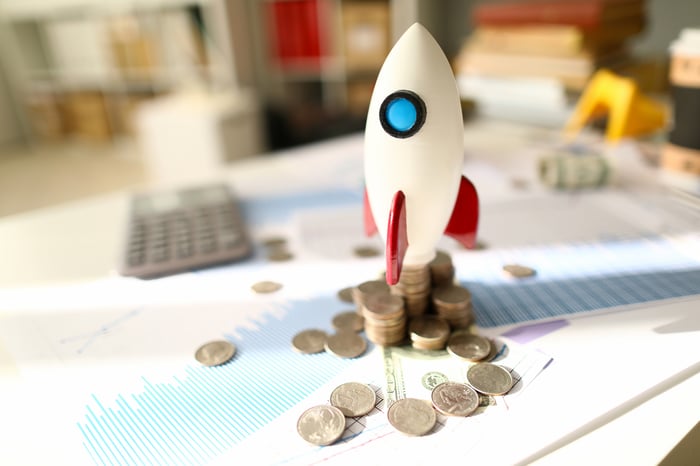
Over long periods of time, the stock market is practically unrivaled in the return column. But over the past couple of years, stocks have been lapped many times over by the returns of cryptocurrencies.
Since the coronavirus crash in March 2020, the widely followed S&P 500 has doubled in value, as of March 2. But according to CoinMarketCap.com, the aggregate value of all digital currencies has catapulted more than 12-fold to $1.94 trillion since hitting their March 2020 low.
Although brand-name cryptocurrencies are responsible for the bulk of this nominal increase in market value, it’s high-flying tokens like Shiba Inu ( SHIB 1.78% ) that have garnered all the attention.
Shiba Inu-inspired coins were on fire in 2021. Image source: Getty Images.
Despite soaring in 2021, Shiba Inu is bad news
Last year, Shiba Inu was virtually unstoppable. At its peak intrayear gain in late October, it had increased in value by more than 121,000,000% from where it began 2021. It ultimately ended higher by around 46,000,000%. Not surprisingly, these historic gains made Shiba Inu one of the most-searched cryptocurrencies in the U.S. last year.
A number of factors have worked in SHIB’s favor, including increased visibility via new crypto exchange listings and the launch of the decentralized exchange ShibaSwap in July 2021. Shiba Inu is also benefiting from certain crypto market dynamics (e.g., minimal short-selling activity and no derivatives/options with which to bet against SHIB) as well as the excitement surrounding numerous upcoming upgrades and ecosystem product launches.
But in spite of SHIB’s success, it’s impossible to overlook its shortcomings. For example, Shiba Inu has no clearly defined competitive advantages. At the moment, it’s nothing more than an ERC-20 token built on the Ethereum ( ETH 0.41% ) blockchain. In simpler terms, it’s a payment coin. There is no shortage of payment coins among the nearly 18,000 listed digital currencies on CoinMarketCap.com. Without true differentiation, SHIB will have a nearly impossible task of standing out in a crowded space.
To build on this point, it’s not even a particularly popular payment coin. While Shiba Inu is extremely popular on social media platforms, only 641 mostly obscure merchants are accepting SHIB as a form of payment. That’s a drop in the bucket when you consider there are over 32 million businesses in the U.S. alone and north of 500 million entrepreneurs globally.
Historic precedence would also suggest Shiba Inu’s future points much lower. In previous instances where payment coins or protocol tokens on payment networks delivered historic short-term gains, they almost always went on to lose 93% to 99%+ of their value in the 12 months to 26 months following their respective peaks. A similar fate probably awaits Shiba Inu.

Image source: Getty Images.
This crypto duo offers much more for investors than Shiba Inu
To be fair, a lot of cryptocurrencies (not just Shiba Inu) are unlikely to live up to their frothy valuations over the long run. But there can be significant winners in the crypto arena.
As I spanned the digital currency landscape in March, two cryptocurrencies stood out as markedly better buys than SHIB.
Avalanche
The first cryptocurrency to buy in a heartbeat over Shiba Inu in March is Avalanche ( AVAX 0.26% ). As of March 2, it was the 10th-largest crypto by market cap ($20.6 billion).
Avalanche and its smart contract-driven blockchain network — smart contracts facilitate, verify, and enforce the negotiation of a contract between two parties — offer three very clear advantages that should allow it to succeed over time.
To start with, Avalanche’s network is fast. If you want to send money, data, or files on Avalanche’s blockchain network, your transaction will complete in less than two seconds. Compare that to the payment-focused Bitcoin ( BTC -0.45% ) or smart-contract rival Ethereum where transaction finality respectively averages 60 minutes and six minutes.
The second reason Avalanche stands out from the crowd is its ability to scale. Rapid block finality is only pertinent if the network in question can handle a lot of transactions at once. Bitcoin and Ethereum are only capable of 7 and 14 transactions per second (TPS), respectively. Meanwhile, Avalanche can handle more than 4,500 TPS, according to its developers. Though still some distance away from payment processor Visa, which is capable of 24,000 TPS, Avalanche has shown it can scale faster than virtually all other blockchain networks.
But the real dangling carrot for Avalanche is what’s included on its network. The third advantage is the incorporation of the Ethereum Virtual Machine (EVM) on its blockchain. The EVM is what the software developers use to create decentralized applications (dApps) on Ethereum’s blockchain. Since Avalanche offers superior speed and scalability, along with lower transaction fees, relative to Ethereum, EVM’s inclusion should encourage dApp developers to come to its network.
Recent dApp protocol-revenue data does suggest this is happening. According to TokenTerminal.com, Avalanche has brought in $41.6 million in dApp protocol revenue over the trailing 90 days. But based on the $17.6 million generated over the trailing 30 days, its three-month run-rate is now closer to $53 million.

Image source: Getty Images.
IOTA
The second cryptocurrency that can confidently be bought in a heartbeat instead of Shiba Inu in March is IOTA ( MIOTA ). IOTA is certainly a more under-the-radar crypto, with a market cap of only $2.2 billion.
What makes IOTA so special is the uniqueness and efficiency of its network, as well as the fact that it has practical, real-world application.
Unquestionably, what stands out most about IOTA is that it’s not a blockchain-based network. Rather, its developers are utilizing what they refer to as the “Tangle.” The Tangle is a directed acyclic graph (DAG) which requires each new transaction to confirm two previous transactions. As the network grows and more transactions are validated, these validation lines begin to look something like a tangled web. That’s how developers came up with the “Tangle.”
There are a number of advantages to leaning on DAG as opposed to blockchain. For instance, blockchain-based networks require votes from users to generate and validate blocks. These are instances where delays can slow a network or make it costlier. With no validators needed, IOTA’s network is designed to grow more efficient with each passing transaction. On average, payment transactions complete in a few seconds.
Best of all, the DAG solution ensures that transactions on its network are (drum roll) free! That’s a significant competitive edge over most cryptocurrency networks and existing payment infrastructure.
Equally exciting, IOTA introduced staking in December 2021, which allows IOTA holders to earn passive income in the form of new tokens. One of these new tokens, Assembly, will offer free smart contract-based transactions when its network launches later this year.
A final reason IOTA is a much smarter buy than Shiba Inu in March is its real-world use case. In February 2021, IOTA announced a partnership with well-known IT company Dell Technologies ( DELL -1.20% ). Three years ago, Dell launched its Data Confidence Fabric (DCF), which aimed to track the journey of data from the edge of the cloud to its destination. IOTA is aiding with scaling and securing Dell’s DCF as well as logging the trust rating of this data in its Tangle. This is one of many reasons IOTA belongs in your portfolio well before SHIB.
This article represents the opinion of the writer, who may disagree with the “official” recommendation position of a Motley Fool premium advisory service. We’re motley! Questioning an investing thesis – even one of our own – helps us all think critically about investing and make decisions that help us become smarter, happier, and richer.
This news is republished from another source. You can check the original article here



